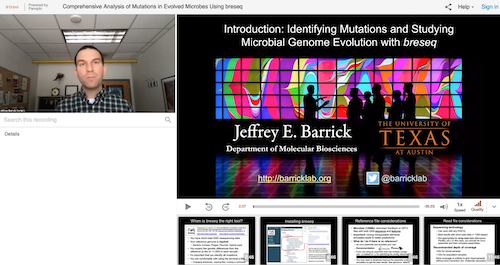breseq
| Learn more | |
|---|
| Download | |
|---|
Comprehensive Analysis of Mutations in Evolved Microbes Using breseq
ASM Microbe 2021 On-Demand Workshop (June 20-24)Introduction: Identifying Mutations and Studying Microbial Genome Evolution with breseq

Joan Slonczewski
Kenyon College Identifying Adaptive Paths in Host-Plasmid Coevolution Using breseq
Olivia Kosterlitz
University of Washington
Vaughn Cooper
University of Pittsburgh

Adam Feist
University of California, San Diego

Zoom Workshop: Advanced Topics (July 22, 2021)
Zoom Workshop: Introductory Topics (July 20, 2021)
breseq -l 80 -r REL606.gbk SRR2584524.fastq.gz
View Results Example 1b: What the results look like if you run this same clonal sample in polymorphism mode (LTEE Ara+1 50,000 generations, Clone A)
breseq -p -l 80 -r REL606.gbk SRR2584524.fastq.gz
View Results Example 2: Results for another evolved clone that was sequenced with longer reads (LTEE Ara+1 50,000 generations, Clone B)
breseq -r REL606.gbk SRR2584534_1.fastq.gz SRR2584534_2.fastq.gz
View Results Example 3: Analyzing the mixed population that both of these clones were isolated from (LTEE Ara+1 50,000 generations, Population)
breseq -j 8 -p -r REL606.gbk SRR6173952_1.fastq.gz SRR6173952_2.fastq.gz
View Results Example 4: Results from mapping to reference genome of a closely related strain–many predictions (links removed to save disk space).
breseq -r NC_000913.3.MG1655.gbk SRR2584534_1.fastq.gz SRR2584534_2.fastq.gz
View Results Example 5: Analyzing an E. coli cell that contains a plasmid
breseq -r E._coli_W3110_NC_007779.1.gbk -r GFP_Plasmid_SKO4.gbk AR_E1_GTTTCG_L005_R2_001.fastq.gz AR_E1_GTTTCG_L005_R1_001_1.fastq.gz AR_E1_GTTTCG_L005_R1_001.fastq.gz AR_E1_GTTTCG_L005_R2_001_1.fastq.gz
View Results Example 6a: Locating the insertion site of an integration cassette in the A. baylyi genome using a junction reference (best option)
breseq --junction-only-reference pBTK622_tdk-kanR_cassette_for_Golden_Transformation.gbk -r Acinetobacter-baylyi-ADP1-WT.gff3 G2_CCGTCC_L007_R1_001.fastq.gz G2_CCGTCC_L007_R2_001.fastq.gz
View Results Example 6b: Same sample not using junction reference
breseq -r pBTK622_tdk-kanR_cassette_for_Golden_Transformation.gbk -r Acinetobacter-baylyi-ADP1-WT.gff3 G2_CCGTCC_L007_R1_001.fastq.gz G2_CCGTCC_L007_R2_001.fastq.gz
View Results Example 6c: Same sample using targeted mode
breseq -t -r pBTK622_tdk-kanR_cassette_for_Golden_Transformation.gbk -r Acinetobacter-baylyi-ADP1-WT.gff3 G2_CCGTCC_L007_R1_001.fastq.gz G2_CCGTCC_L007_R2_001.fastq.gz
View Results Example 7a: Mapping to a de novo assembled reference
breseq -r assembly.fasta SRR2584534_1.fastq.gz SRR2584534_2.fastq.gz
View Results Example 7b: Mapping to a de novo assembled reference using contig mode (best option)
breseq -c assembly.fasta SRR2584534_1.fastq.gz SRR2584534_2.fastq.gz
View Results
Feedback and Bug Reporting
Please report bugs on GitHub.Tutorial input and results files for breseq book chapter
Deatherage, D.E., Barrick, J.E.. (2014) Identification of mutations in laboratory-evolved microbes from next-generation sequencing data using breseq. Methods Mol. Biol. 1151:165-188. «PubMed»| Download Link | Size | Description |
|---|---|---|
| |
267M | Input files for clonal sample |
| |
1.2M | Output files for clonal sample |
| |
1.4G | Input files for time-course of population samples |
| |
11M | Output files for time-course of population samples, including comparison |
| |
199K | Examples of using unassigned evidence to predict complex mutations |
| |
139K | Example output showing characteristics of poor evidence |
Other Resources
Previous Versions:| |
| |
| |
| |
| |
Barrick Lab > SoftwareList > ToolsBacterialGenomeResequencing
Topic revision: r61 - 2024-10-14 - 00:11:08 - Main.JeffreyBarrick